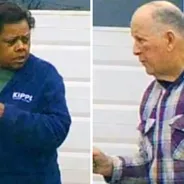This week the American Midwest was gripped with a record freeze as a result of the polar vortex. Every winter, a wide expanse of swirling cold air moves south from the North Pole, creating cold snaps in the United States. However, this year the temperatures are unusually low, plunging far below the norm in many states, even those with a high winter tolerance.
In Wisconsin, Michigan and Illinois, a state of emergency has been declared. Officials in Iowa warned residents to "avoid taking deep breaths" and to "minimize talking" if they venture outside. And in Minnesota, the temperature hit 26 degrees below zero (Fahrenheit), with a windchill of 53 below zero, making it impossible to deliver beer. Under this arctic blast, frostbite can set in within minutes, and at least seven deaths have been linked to the extreme weather.
It's gotten so cold in Chicago that the train tracks appear to have been set on fire, a striking image that has captivated many people on social media. However, the train tracks are not literally on fire. The flames sprout from a tubular gas-fed system that runs adjacent to the rails. The heat thaws the tracks, melting ice and snow that clogged railway switch points. Also, if the extreme cold shrinks the metal and the rails pull apart, the fire helps the metal expand so they can be re-attached.
This extremely badass-looking heating system is used by several railways in the United States, and Chicago Metra uses it whenever the temperature is below freezing. But while the procedure may be routine, windchills of 50 below zero are definitely not normal in the Windy City. No matter how cold it is in your state, be thankful you're not one of the Metra crew members, who are working 12-hour shifts to monitor the flames.
Metra says the trains run on diesel fuel, which "combusts only with pressure and heat, not open flames," therefore it's safe for the trains to run over the flames. However, their previous method for heating the tracks wasn't so safe: sticking pots full of kerosene between the track ties, and lighting them by hand.
"We all used to carry this stuff. I called it skunk oil," stated John Meyer, the director of engineering for Metra, on the commuter railroad's website. "We poured it in a 2-gallon can, poured it out, and threw a match in it, and it'd start a fire along all the rails. We're talking in the mid-'70s. Nowadays you'd get in big trouble doing that."
[[instagramwidget||https://www.instagram.com/p/Bs6Qpf4jf1Q/]]adsfsd
Well, stay safe, Chicagoans. Remember, you can always keep warm by scarfing down some deep dish pizza, performing a Harold with your improv team and rewatching clips of the Chicago Cubs winning the World Series in 2016. If that doesn't work, start hoping for some 'global warming,' like Donald Trump (even though extremely cold weather events are a possible consequence of global warming).










